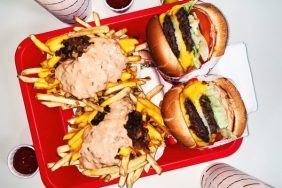Chef Tom Douglas knows Seattle’s restaurant scene intimately. He’s been in it for almost 40 years, building an empire that now includes 23 food-related businesses including 18 restaurants, the Hot Stove Society cooking school, catering company Palace Ballroom, and Prosser Farm. The James Beard award-winning culinary entrepreneur answered our questions about the Emerald City’s edible treasures while juggling duties at Feast Portland, a food and drink festival.
Crave: How did you initially get into the food industry and the restaurant business?
Chef Tom Douglas: Oh, that’s a long time ago. Initially, probably from my high school days. I was in the Home Ec class, mostly to meet girls. I settled in. I loved to cook. Finally, my guidance counselor got me a walk-through at the Hotel Dupont in Wilmington, Del., and that’s where I got my first cook’s helper’s job. Not long after that, I turned 18, wanted to see the world, got in my car, traveled around the country, and ran out of money in Seattle.
What would you say constitutes Pacific Northwest fare?
The amazing breadth of seafood, and berries, and wild mushrooms. Here, salmon is king–quite literally in name but also in stature and in importance to the environment and to the Indians when they were here and to the traders and as an edible source for the early Americans.

Photo: Salmon Kebob Plate at Lola restaurant in Seattle.
What other kinds of foods, sweet or savory, are trademarks of the region?
Huckleberries. Before everything was refined, the indigenous people would use crushed berries and fruits–like salmonberries, a coral-colored berry–as their sugar. We use lots of beets for sugar. We use sweet potatoes for sugar. We work those into our sweet desserts.
Here it’s all about being natural and trying to use everything from our own local ingredients. We have our own farm on the east side of the state which is irrigated by the mountain snows. We grow nectarines, melons, apples, plums. Right now, we’re harvesting the last of the pepper crop, the last of the eggplants. We have 3,500 tomato plants that are still producing. We grow everything.

Photo: Prosser Farm on Facebook.
That must mean the menus at your restaurants change seasonally?
Oh, absolutely. Especially with Prosser Farm. Right now, you’ll find some melons on there. The last-of-the-season cantaloupes are being picked. At Feast Portland last night, I did a Peppernata with the summer chanterelles that we foraged for and then all the peppers we have at the farm, I ground them all up with olive oil, capers, and anchovies and made a beautiful Peppernata on our pecan flaxseed toast. We’re all about vegetables. We had pickled zucchini with that. We have an embarrassment of riches right now.
Other than the venues you own and operate, where do you like to go out to eat in Seattle?
There’s so many. I love Loulay, downtown Seattle. I love Wild Ginger; they do Pan-Asian cuisine. I love Le Pichet, a French bistro in the Pike Place market area. This time of year, sitting out on the deck of The Pink Door restaurant, an Italian trattoria–fabulous. Omega Ouzeri, a little Greek restaurant on Capitol Hill. I love going for old Chinese, my favorite being Tai Tung Restaurant: it’s super fun, very old-fashioned, menus in Chinese on the walls. It’s a cool place.
Do you have a guilty pleasure food? Something that might even be embarrassing to admit?
[Laughs] Well, there are so many. Where do I start? I love barbecue potato chips. There’s certainly some guilt and pleasure in those. Number one: I shouldn’t be eating them, because I’m already a massive human. Number two: I kind of like ‘em. They’re pretty fun and delicious. So there’s that.
We made a cookie in our bakery that tastes like a Nutter Butter, you know, that classic Nabisco Nutter Butter, but ours is way tastier. I love to have an éclair. Our maple éclairs are really, really good.

Photo: Maple Eclair at Dahlia Bakery in Seattle.
I’m known as a pretty fancy chef, but in Chinatown they make these water soups. I don’t know if you know what I mean by that but literally people didn’t have any money, so they would just put cabbage, water, and maybe a slice of onion in a pot and that would be soup. I’m kind of a fan of those water soups. I think they’re reflective of a time and place when things weren’t so good for a lot of people. That kind of thing really makes me think about our history, and the history of food, and what really is important.
How have you seen the restaurant industry change over the years?
In the beginning, when I first started, it changed in that America chefs became more important and were doing interesting foods outside of being French, or Swiss, or German, or Italian, which is kind of what you used to have to be in order to get a job at a major hotel or any real restaurant of stature. Now, American chefs have been celebrated for the last thirty, thirty-five years.
It’s changing again, dramatically, as we speak. This time, we’ve gone through all the modernist cuisine, and sous vide, and manipulating food into things we never knew it could be. It’s much more about our teams now: health care, minimum wage, paid time off, predictive schedules. As a restaurateur, this is the first time where our industry is not as much focused on the food as it is about all the people who work in our business. I think it’s healthy to have this conversation.
Seattle is certainly leading the way when it comes to opportunities for young cooks and to make a professional living. It’s a very interesting time. We’re all used to seeing chefs on TV, you know? And now it’s chefs as business people and stewards of the Earth.
Chef and food photos provided by Tom Douglas.








